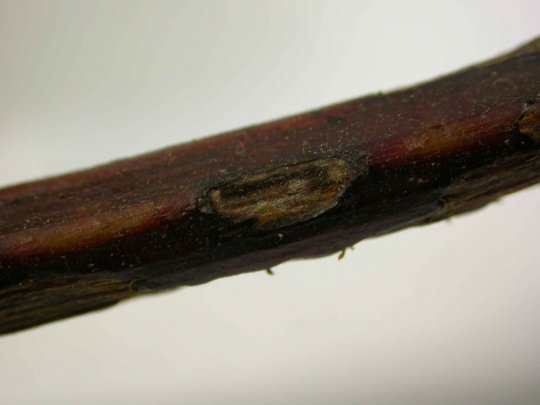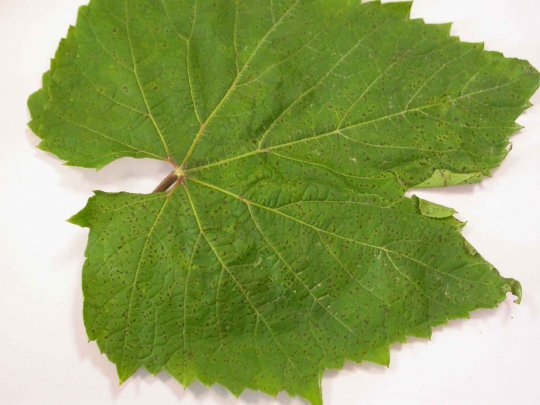Caused by the fungus Elsinoë ampelina, also known as spotted anthracnose, this disease is now very rare in Europe and is found in vineyards or stock nurseries that have not been treated against downy mildew. Anthracnose is, with excoriosis, one of the only diseases originating in Europe and exported to America.
2.4.1.g Anthracnose
What are the symptoms of anthracnose?
All green vine organs can be affected by anthracnose:
- Shoots: the young parts of the shoots are the most susceptible to the fungus. Initially, irregular black spots appear which evolve into grey cankers with a black ring. The interior is fibrous and when these lesions are numerous, they merge and branch extremities appear scorched. Affected branches are thus weakened, and their growth can take a crooked shape if the necroses are numerous.
- On leaves: in spring, small circular spots of 1 to 5 mm in diameter are observed. The grey centre of the lesions dries up and falls off, leaving a hole with a black border. If the veins are affected, the leaves shrivel. If the entire leaf is affected, it cannot develop and becomes deformed or dries up.
- On inflorescences and bunches: For instances of severe attacks of anthracnose, inflorescences and bunches can dry out completely. Circular black dots appear first on the berries and stalks, which then develop into cankers with a black border.
Extracts from Vigne Vin Occitanie.
Can the symptoms be confused with other diseases?
Anthracnose symptoms are very recognizable with the appearance of black spots and cankers on the branches. This disease can be confused with Phomopsis dieback (excoriosis) which shows similar symptoms on the shoots and leaves. However, anthracnose is more widespread than excoriosis (see section on Phomopsis dieback or excoriosis ).
What is the biology of this fungus?
Elsinoë ampelina is a specific grapevine fungus, and its cycle is still poorly understood. At the end of the summer, the edges of the cankers turn into sclerotia, which are most likely the winter storage form of the fungus. The following spring, these sclerotia germinate and produce conidia (asexual spores), after at least 24 hours of exposure to moisture at a temperature above 2°C. Conidia carried by raindrops contaminate the vine's green organs, even if there is less than 2 mm of rain, and constitute the primary infections.
These are likely to be the cause of secondary infections, which occur from conidia formed on the primary lesions. Anthracnose spreads from localized outbreaks. During the growth cycle, the fungus can be preserved in the form of sclerotia and/or by mycelia, which can remain in a latent state in the lesions and develop in very humid conditions.
What practices favour anthracnose? What preventive measures are there?
Very damp conditions in the spring, high temperatures, rich soil and lowlands, and excessive vigour of the vines can favour anthracnose. It is the main disease affecting tropical and subtropical vineyards. It would appear that certain grape varieties are more sensitive than others to anthracnose, such as Cabernet and Carignan.
Prophylactic solutions: The most effective prophylactic method consists of eliminating affected branches during pruning, and removing them entirely from the plot or burning them. The sclerotia, which are the dormant form, are present on the bark, and in the cankers and mummified fruit. Controlling vigour through fertilization or grassing is another key factor.
What treatments are available to combat this fungus?
In France, there is no registration category for fungicides to treat anthracnose. Spring and summer treatments with anti-mildew fungicides enable some control of this disease. However, in the context of the development of varieties resistant to downy mildew and powdery mildew, it is a parasite that should be monitored in the same way as black rot.
In the absence of control of the fungus through the secondary effects of the commonly used fungicides, it could quickly develop on susceptible varieties, especially if the spring is wet. Note that some rootstocks are sensitive to the fungus in the stock nursery growing conditions (3309 C, 101-14 Mgt, SO4, etc.).
It may be necessary to carry out treatments on plots when the spring is very rainy and there have been previous attacks, as the production of wood can be reduced to almost nothing in the event of a severe outbreak.
Extract from Vigne Vin Occitanie.
At what stage of the vines' development should treatment begin?
Contamination can begin as early as spring, the traditional treatments against downy and powdery mildew implemented at this period also serve as a treatment against anthracnose.


